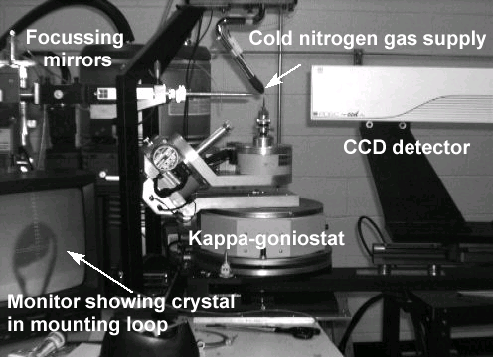ADSC Quantum 1 Single Module CCD Detector
The core of the ADSC CCD detectors is a 1x1 inch semiconductor chip with 1150x1150 pixels resolution. A 10x10 cm imaging phosphor faceplate emits photons when hit by X-rays. These photons are collected through an optical taper and detected on the CCD array. Readout times are extremely fast, and due to the high resolution the detector can be moved close to the crystal, which enables very simple data collection strategies comparable to image plates. The big advantage compared to IPs is the absence of any mechanical parts in the detector box. The 4-module Quantum 4 detector is the latest and most advanced of the commercial CD detectors from ADSC.

Our #2 X-ray diffractometer equipped with a ADSC Quantum-1 CCD detector, a Kappa-Goniostat, Rigaku Ru-200 anode with ADSC/Supper focussing mirrors and a heat exchanger type cryo-cooler (Design Sean Parkin).
Note the monitor showing a mounting loop as used
by us (and most people by now) in flash cooling of protein
crystals. To learn more about the techniques of cryo-cooling of crystals
click on the image of crystals in a hanging drop picture.
Click here for my brief overview of
the advantages of cryo-crystallography
![]() Back to X-ray Tutorial Introduction
Back to X-ray Tutorial Introduction
LLNL Disclaimer
This World Wide Web site conceived and maintained by
Bernhard Rupp (br@llnl.gov)
Last revised November 02, 1999 16:59
UCRL-MI-125269